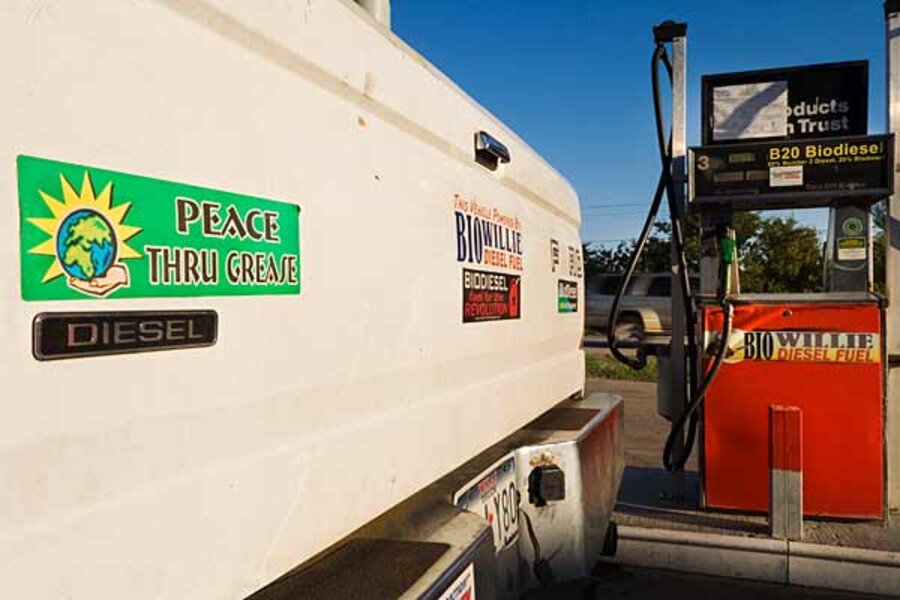Supreme Court declines Bush bumper sticker case
| Washington
The US Supreme Court on Tuesday declined to hear the appeal of two Colorado residents who were excluded from a speech by President Bush in 2005 because White House aides saw them arrive in a car with a bumper sticker that proclaimed: “No More Blood For Oil.”
Although they had earlier obtained tickets to the event, passed through a security checkpoint, and said they had no intention of being disruptive, White House officials and volunteers ordered them removed from the venue by two uniformed police officers. The officials were acting under a Bush administration policy of barring from then-President Bush’s public appearances anyone who might disagree with him.
The speech was held at a privately owned museum in Denver but was open to members of the public who obtained tickets beforehand. As an official presidential speech, it was paid for with government funds.
The two ejected individuals, Leslie Weise and Alex Young, never said or did anything disruptive and were ejected before the speech began. They later filed a lawsuit claiming Bush aides violated their First Amendment right to display a bumper sticker on a car and not face punishment from government officials who object to the message.
A federal judge threw the lawsuit out. A federal appeals court panel agreed. The panel, in a 2-1 decision, said there was no “clearly established” constitutional right not to be excluded from a speech by the president because of a bumper sticker on the car in which they arrived.
"No specific authority instructs this court (let alone a reasonable public official) how to treat the ejection of a silent attendee from an official speech based on the attendee’s protected expression outside the speech area,” wrote Judge Paul Kelly of the Tenth US Circuit Court of Appeals.
In a dissent, Judge William Holloway said the ejection caused “extreme embarrassment and humiliation” to the two plaintiffs solely because they had arrived at the speech in a car with a bumper sticker that government officials found concerning.
“It is simply astounding that any member of the executive branch could have believed that our Constitution justified this egregious violation of plaintiff’s rights,” Judge Holloway wrote.
Holloway quoted the Supreme Court’s 1964 landmark First Amendment decision, New York Times v. Sullivan: “The right of an American citizen to criticize public officials and policies and to advocate peacefully ideas for change is the central meaning of the First Amendment.”
The Supreme Court did not explain why the justices declined to hear the case.
In a dissent, Justices Ruth Bader Ginsburg and Sonia Sotomayor said they would have agreed to hear the appeal.
“I cannot see how reasonable public officials, or any staff or volunteers under their direction, could have viewed the bumper sticker as a permissible reason for depriving Weise and Young of access to the event,” wrote Justice Ginsburg.
She added that she could see “only one arguable reason for deferring the question this case presents.” The justice noted that the two people being sued were volunteers who had acted on instructions from White House officials at the event. The federal Volunteer Protection Act might have shielded the volunteers from the lawsuit. But Ginsburg said the White House officials may not enjoy similar protection.
“Federal officials themselves … gain no shelter from that Act,” she wrote. “Suits against the officials responsible for Weise’s and Young’s ouster remain pending and may offer this Court an opportunity to take up the issue avoided today.”
In a 1996 case, the Sixth US Circuit Court of Appeals ruled in favor of campaign workers who refused to allow a person wearing a Bill Clinton button to attend a Bush-Quayle campaign rally. The campaign committee maintained a policy barring rally participants from carrying signs or wearing buttons critical of then-President George H. W. Bush.
The Clinton supporter was allowed to attend once she surrendered the Bill Clinton button.
In the case involving the 2005 incident, the Tenth Circuit majority said the Bush speech was similar in that the president has a First Amendment right to control the message at his speech.
Holloway, the dissenting judge, disagreed. He said the Bush-Quayle event in the 1996 case was a private rally held by a private entity, the Bush-Quayle election committee. Under those circumstances the committee was entitled to attempt to control the rally’s message by excluding signs and buttons of opposing candidates.
“Our case deals with a public event, and plaintiffs did not attempt to express any opinion in the course of their attendance,” he wrote.
The Bush aides named in the lawsuit were both local volunteers at the Denver event. They said in their briefs that they are entitled to qualified immunity from such lawsuits because they were just following the instructions of White House officials who are themselves protected by qualified immunity.
Lawyers for both men also argue that the Bush event in Denver was a private event because it took place in a privately-owned museum.
“The museum where the president gave his speech was private property, and because tickets were required for admission, the event was a limited private forum,” wrote Brett Lilly, a lawyer in Wheat Ridge, Colo. Under those circumstances, he said, the president is under no obligation to share the stage with others.
Lawyers for Weise and Young disagree with this analysis. “When the government decides to hold an event paid for by taxpayers and open to the public, and when the government itself makes all the decisions about the event, First Amendment rights do not turn on whether the event occurred at a municipal auditorium or a private museum,” wrote Christopher Hansen, a lawyer with the American Civil Liberties Union.





